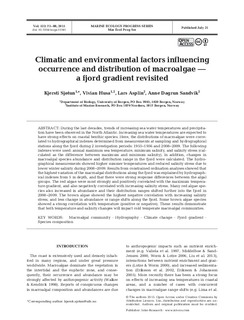| dc.contributor.author | Sjøtun, Kjersti | |
| dc.contributor.author | Husa, Vivian | |
| dc.contributor.author | Asplin, Lars | |
| dc.contributor.author | Sandvik, Anne Dagrun | |
| dc.date.accessioned | 2015-07-24T11:38:25Z | |
| dc.date.accessioned | 2015-07-27T09:17:38Z | |
| dc.date.available | 2015-07-24T11:38:25Z | |
| dc.date.available | 2015-07-27T09:17:38Z | |
| dc.date.issued | 2015-07-21 | |
| dc.identifier.citation | Sjøtun K, Husa V, Asplin L, Sandvik AD (2015) Climatic and environmental factors influencing occurrence and distribution of macroalgae — a fjord gradient revisited. Mar Ecol Prog Ser 532:73-88 | nb_NO |
| dc.identifier.issn | 0171-8630 | |
| dc.identifier.uri | http://hdl.handle.net/11250/293618 | |
| dc.description | - | nb_NO |
| dc.description.abstract | During the last decades, trends of increasing sea water temperatures and precipitation have been observed in the North Atlantic. Increasing sea water temperatures are expected to have strong effects on coastal benthic species. Here, the distributions of macroalgae were correlated to hydrographical indexes determined from measurements at sampling and hydrographical stations along the fjord during 2 investigation periods: 1955-1956 and 2008-2009. The following indexes were used: annual maximum sea temperature, minimum salinity, and salinity stress (calculated as the difference between maximum and minimum salinity). In addition, changes in macroalgal species abundance and distribution range in the fjord were calculated. The hydrographical measurements showed higher summer temperatures and reduced salinity stress due to lower winter salinity during 2008-2009. Results from constrained ordination analyses showed that the highest variation of the macroalgal distributions along the fjord was explained by hydrographical indexes from 5 m depth, and that there were strong response differences between the algal groups. The red algae were most strongly and positively correlated with the maximum temperature gradient, and also negatively correlated with increasing salinity stress. Many red algae species also increased in abundance and their distribution ranges shifted further into the fjord in 2008-2009. The brown algae showed the highest negative correlation with increasing salinity stress, and less change in abundance or range shifts along the fjord. Some brown algae species showed a strong correlation with temperature (positive or negative). These results demonstrate that both temperature and salinity changes will impact cold temperate macroalgal communities. | nb_NO |
| dc.language.iso | eng | nb_NO |
| dc.publisher | Inter-Research | nb_NO |
| dc.title | Climatic and environmental factors influencing occurrence and distribution of macroalgae – a fjord gradient revisited | nb_NO |
| dc.type | Journal article | nb_NO |
| dc.type | Peer reviewed | nb_NO |
| dc.date.updated | 2015-07-24T11:38:25Z | |
| dc.source.pagenumber | 73-88 | nb_NO |
| dc.source.volume | 532 | nb_NO |
| dc.source.journal | Marine Ecology Progress Series | nb_NO |
| dc.identifier.doi | 10.3354/meps11341 | |
| dc.identifier.cristin | 1254748 | |
